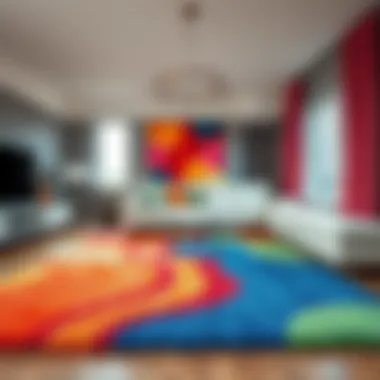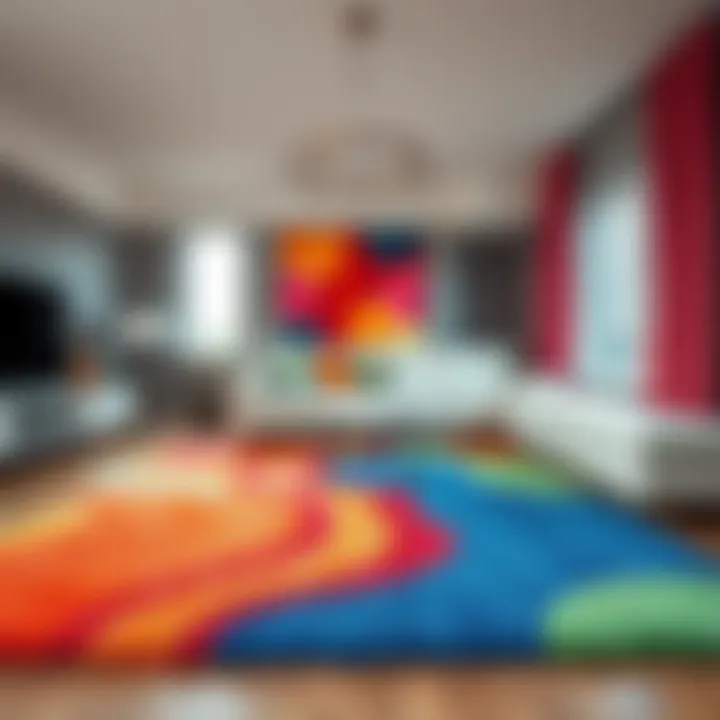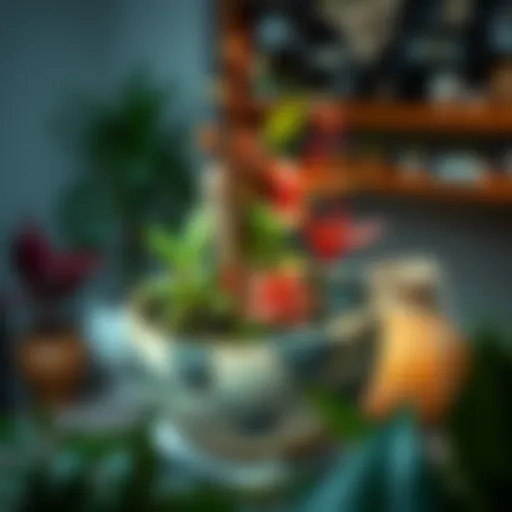Indoor Rugs: Materials, Styles, and Care Tips


Intro
When it comes to transforming a house into a home, indoor rugs play an unsung role. They serve not only as decorative elements but also provide comfort, warmth, and even noise reduction. Depending on your desires, the right rug can enhance your interior aesthetics significantly. Homeowners, designers, and DIY enthusiasts will find themselves bombarded with options at retailers like Lowe's, and understanding the ins and outs of these choices can make all the difference.
Today, we explore the world of indoor rugs, diving into the myriad styles, materials, and sizes available. We also consider maintenance techniques—because a beautiful rug is only effective if it is well taken care of. Sustainability has become an important aspect in the world of decor as well, and it deserves attention. After all, presenting a lovely home shouldn't come at the expense of our planet.
In this article, expect to uncover valuable insights about carpet choices that suit modern interiors, select the perfect fit for various spaces in your home, and discover maintenance tips that ensure longevity. By understanding these aspects, you will be better equipped to make informed decisions about your indoor rugs.
So let’s roll out the red carpet and begin this exploration!
Preamble to Indoor Rugs
In the realm of interior design, indoor rugs play an essential role, serving as both functional elements and aesthetic enhancements within a space. This section delves into the importance of indoor rugs, outlining their benefits and considerations that homeowners, designers, and decorators should keep in mind when selecting the perfect rug for their environments.
The Importance of Rugs in Interior Design
Rugs are more than just decorative flourishes tossed onto a floor; they act as subtle anchoring points around which a room's design can revolve. The right rug can transform an ordinary space into one that exudes warmth and character. For instance, think about how a richly colored Persian rug can infuse a stark, modern room with a sense of history and story.
Moreover, indoor rugs can set a mood. A plush, shaggy rug invites comfort, perfect for cozy family gatherings, while a geometric patterned rug can evoke a sense of contemporary chic, appealing to younger audiences or those who embrace modern aesthetics. By strategically placing rugs, one can delineate areas within larger spaces, such as distinguishing living rooms from dining areas, thus enhancing functionality without compromising style.
Rugs also serve as a layer of protection for flooring. They can shield hardwood or tile from scratches and scuffs, prolonging the life of the underlying surface. Furthermore, they contribute to the acoustics of a room by absorbing sound, making spaces feel more intimate and refined. Thus, a rug is not merely an accessory but is integral to creating a well-rounded interior that balances tactile comfort with visual appeal.
Types of Indoor Rugs Found at Lowe's
Lowe's offers a variety of indoor rugs to cater to diverse tastes and needs. Here’s a look at some of the popular types available:
- Area Rugs: These are versatile options that can define spaces and come in various sizes, shapes, and materials. Area rugs can range from small accent pieces to large, room-sized options.
- Runner Rugs: Ideal for hallways or narrow spaces, runner rugs provide a stylish way to enhance functionality in areas where a full area rug may not fit.
- Persian and Oriental Rugs: These classic styles often bring a timeless appeal with intricate designs and patterns, making them suitable for both traditional and modern interiors.
- Contemporary Rugs: Featuring bold colors and patterns, these rugs can serve as statement pieces, appealing to those looking for modern flair in their decor.
- Kids' Rugs: Specifically designed for children's rooms, these rugs often feature playful designs and are made with softer, safer materials.
Each type offers a unique characteristic that can enhance the overall feel of your interior space, combining both form and function.
Whether you are a seasoned designer or a homeowner tackling a DIY project, understanding the importance of indoor rugs and the variety available will empower you to make choices that resonate with your vision.
Styles of Indoor Rugs
When it comes to crafting a living space that resonates with personal style, the selection of rug styles plays a crucial role. The right rug can act as an anchor in a room, bringing together various elements of design while also adding warmth and texture. Each rug style carries its own unique essence, enhancing the room's aesthetics and offering comfort. For homeowners, designers, and even DIY enthusiasts, understanding these styles is more than just a mere exploration – it’s about aligning the rug’s personality with the space’s character.
Contemporary and Modern Rugs
Contemporary and modern rugs are often marked by their minimalist designs and bold colors that push the envelope. These styles focus on clean lines and geometric patterns, making them suitable for those who appreciate sleek, uncluttered spaces. Think about it: in a room filled with neutral tones, a vibrant, patterned rug can serve as an eye-catching centerpiece. Brands like Nourison and Ruggable offer a myriad of options that embody this aesthetic, suitable for both relaxed and urban vibes.
One striking aspect of contemporary rugs is their versatility. These pieces can be easily incorporated into a variety of settings, from a modern loft to a cozy family room. Consider showcasing such rugs in high-traffic areas, as they often come in durable materials and are made to withstand everyday wear and tear.
Traditional and Vintage Designs
Traditional and vintage rugs weave a narrative into the fabric of your home, often characterized by intricate patterns and classical motifs. These rugs evoke a sense of history and craftsmanship, appealing to those with an appreciation for timeless beauty. Designs like Persian or Oriental reflect the artistry of bygone eras, which adds a depth of character to any room.
But why choose vintage? Beyond aesthetics, vintage rugs are typically made from natural fibers and can offer a sense of authenticity that new rugs may lack. They’re perfect for creating a warm, inviting atmosphere, especially in rooms that want to exude a touch of nostalgia. Pair a vintage rug with vintage furniture, and you have a match made in decor heaven.
Shag and Plush Rugs
Shag rugs have made a notable comeback, bringing a touch of retro flair back into homes. With their long fibers and fluffy texture, they invite comfort and cosiness. Shag and plush rugs are ideal for spaces intended for relaxation, such as bedrooms and lounges. Picture sinking your toes into a thick shag rug after a long day – it transforms a mundane space into a serene retreat.
These rugs come in various colors and styles, often lending a laid-back vibe that encourages lounging. For example, a fluffy gray shag rug can beautifully complement a modern chair or sofa, creating an inviting nook. Many homeowners select shag rugs for children’s playrooms as well, where the soft fibers can help cushion falls and create a playful atmosphere.
Outdoor Rugs for Indoor Use


While initially designed for the great outdoors, outdoor rugs have found their way inside many homes, thanks to their durability and weather-resistant qualities. These rugs often showcase vibrant colors and patterns, making them suitable for enlivening indoor spaces. Don’t just think of them for porches; many designers use outdoor rugs in kitchens or dining areas.
With their easy-to-clean materials, outdoor rugs can withstand spills and high foot traffic, making them a practical choice for families. A striking striped outdoor rug can add a burst of energy to a hallway or dining space. This adaptability makes outdoor rugs an attractive option for modern living.
"The right rug does more than fill space; it has the power to change your entire perception of a room."
In summary, selecting the style of an indoor rug is fundamental for defining a room's persona. By understanding the diverse styles available—be it contemporary, traditional, shag, or outdoor—homeowners and designers can make informed choices that make their spaces not only stylish but also functional.
Materials Used in Indoor Rugs
When it comes to choosing an indoor rug, the material it’s made from plays a pivotal role in not just how it looks, but also in how it performs over time. Each type of material brings its own set of benefits and drawbacks, making it crucial for anyone purchasing a rug to have a solid understanding of the options available. In this section, we'll delve into three primary categories of rug materials: wool, synthetic fibers, and natural fibers. Knowing the characteristics and maintenance of these materials can help you make an informed decision that aligns with your home design, lifestyle, and ecological values.
Wool Rugs: Durability and Comfort
Wool rugs are often hailed as the gold standard in the world of interior décor. One of the standout features of wool is its incredible durability. Unlike synthetic fibers, which can wear out and fray over time, wool fibers tend to maintain their structural integrity, making wool rugs withstand heavy foot traffic without losing their shape or texture.
Besides durability, wool is celebrated for its comfort. The natural springiness of wool fibers provides a soft feel underfoot, making them perfect for living areas or bedrooms where comfort is paramount. Furthermore, wool is an excellent insulator, helping to keep rooms warm in the winter and cool in the summer.
But, wool does have a couple of considerations. First, initial costs can be higher compared to synthetic rugs. Second, wool can attract dirt and may need special care to keep looking its best. Regular vacuuming is essential, as is occasional professional cleaning to ensure your rug remains a key feature in your home.
Synthetic Fibers: Affordability and Variety
For those on a budget or looking for vast design options, synthetic fibers like nylon, polyester, and polypropylene offer a practical alternative. These materials are typically cheaper than their natural counterparts, allowing for greater flexibility in designs and colors.
Synthetic rugs are often stain-resistant and easy to clean, making them ideal for high-traffic areas or homes with children and pets. For instance, a polypropylene rug can be easily wiped down or spot-cleaned without worrying excessively about fading or wear. This practicality doesn’t mean you have to skimp on style; many synthetic rugs now mimic the look of natural fibers, offering a range from chic modern patterns to classic designs.
Natural Fibers: Sustainability and Style
Natural fiber rugs, made from materials such as jute, sisal, and cotton, are gaining popularity for those looking to create an eco-friendly living space. Jute and sisal, for instance, are biodegradable and sourced from renewable plants, aligning with sustainable design principles. They typically bring a rustic charm to a room, offering unique textures that can brighten up a space easily.
However, natural fiber rugs have particular needs in terms of care and maintenance. They should not be exposed to excessive moisture or direct sunlight, as this could cause degradation in their structure and color. Also, these rugs tend to be less cushy underfoot compared to wool or synthetic materials, which can be a consideration for areas meant for lounging or extensive use.
In summary, natural fiber rugs can be an exquisite addition to modern homes that value sustainability and aesthetic simplicity. Their natural textures can inject warmth and personality into a room, making them an appealing option for many homeowners.
The material of your rug is not just about aesthetics; it deeply affects its functionality, maintenance, and longevity.
Understanding the materials used in indoor rugs allows you to choose the best fit for your home’s atmosphere and function. Each material, whether wool, synthetic, or natural, brings something unique to the table—it's up to you to determine what matters most in your living space.
Choosing the Right Size Rug
Choosing the right size rug is a pivotal aspect that can tie a room together, transforming spaces from ordinary to extraordinary. An ideally sized rug provides a visual anchor and enhances the overall aesthetic appeal of your home, creating a sense of balance and harmony. It can define areas within a room, such as a seating area or a dining zone, guiding the flow of the room while also contributing to the comfort of its inhabitants. Getting the dimensions right is not just about aesthetics; it’s a matter of functionality as well. A poorly sized rug can make a small room feel cramped or a large room feel empty.
Being mindful of the size not only helps in achieving the desired look but also saves you from the hassle of returns or adjustments later. Whether you're designing a cozy nook or an expansive living room, knowing how to choose the right dimensions will serve you well.
Understanding Rug Dimensions
Rug dimensions are often expressed in feet or inches, and knowing the measurements can seem straightforward at first. However, one must take into account the entire room size, furniture arrangements, and even personal style preferences. For instance, a rug measuring 8x10 feet may seem perfect for some spaces, but if your sofa and chairs offer a different scale to the room, that choice can quickly fail to impress.
In general, there are a few standard sizes:
- 5x7 feet: a good fit for smaller rooms or as an accent piece
- 8x10 feet: commonly used in living areas, allowing front legs of furniture to rest on it
- 9x12 feet: ideal for larger spaces with ample seating
When selecting dimensions, consider using a tape measure to visualize how each rug will flow within your space. This allows for an accurate assessment of whether a rug will complement the design or disrupt it.
Tips for Measuring Your Space


Measuring your space accurately is crucial, and a few simple strategies can make this task less daunting:
- Clear the Area: Before measuring, remove any furniture or obstacles that might distort the space's actual dimensions. This gives you a clean slate for an accurate measurement.
- Use a Measuring Tape: A standard 25-foot measuring tape can work wonders. Take multiple measurements to ensure consistency; sometimes walls can be askew or furniture can fool the eye.
- Draw a Layout: Sketch out the room, including the placement of existing furniture. This visual representation helps in determining the best size for your rug while factoring in how the rug interacts with the furnishings.
- Consider Rug Placement: Decide how you'd like to arrange your rug in relation to the furniture. Ideally, the front legs of the sofa should sit on the rug while the back legs rest on the floor, achieving a grounded look.
- Leave Space for Movement: Don’t forget about the need for air and flow. Most experts recommend leaving at least 12 to 24 inches of floor space around the rug for an unobstructed appearance.
Following these tips can guide you in making an informed choice that satisfies both style and functionality. Selecting the right size rug becomes less of a guessing game and more of a strategic decision, leading to a cohesive and inviting environment.
Color and Pattern Selection
When selecting an indoor rug, color and pattern play a pivotal role in shaping the overall aesthetic appeal of a room. The right choices can transform an uninspired space into a vibrant and inviting atmosphere. Beyond mere decoration, colors and patterns can significantly influence mood and perception. Homeowners and designers alike need to carefully consider how hues and designs interact with existing elements of a room including walls, furniture, and lighting.
A well-chosen rug acts not only as a visual anchor but also as a conversation starter, weaving together different components of your living space. In this section, we will delve into the profound effects of colors on room aesthetics as well as share guidance on selecting patterns that marry beautifully with decor.
Impact of Colors on Room Aesthetics
Color influences how we experience a space. For instance, warm colors like red, orange, and yellow can create an intimate and cozy atmosphere. They evoke energy and warmth—perfect for lively areas like living rooms or dining spaces. On the flip side, cool colors such as blue, green, and purple promote calmness and tranquility, making them ideal for bedrooms or relaxation areas.
Considering how light interacts with colors is crucial in the equation. A sunlit room may amplify specific hues, transforming the perceived intensity throughout the day. It’s wise to remember that dark colors can make a room feel smaller, while light colors tend to open up space, giving it an airy feel.
- Tip: Test rug colors in-store under various lighting conditions to see how they change.
- Consideration: Factor in the size of the room; a bold color can work wonders in a large space but might overwhelm a smaller one.
Choosing the right color can significantly improve the mood of a space. Take time to explore hues that resonate well with the energy you wish to evoke.
Choosing Patterns that Complement Decor
Patterns can add depth and dimension to your interior design, creating a focal point that draws the eye. However, selecting the right pattern can be a bit of a balancing act. Complex designs can inject a vibrant life into a room, but if not chosen wisely, they can clash rather than complement existing decor.
- Identify the Existing Style: For traditional themes, a classic Persian rug might echo the ornate characteristics found elsewhere. Conversely, contemporary interiors often suit geometric or abstract designs.
- Mixing Patterns: Don’t shy away from mixing patterns. A striped rug can pair beautifully with floral cushions—just ensure they share a common color for unity.
- Consider Scale: Large patterns can appear overwhelming in small spaces, and vice versa; small patterns can get lost in larger areas. It’s essential to find a balance.
To summarize, color and pattern selection shouldn’t be an afterthought. They are essential elements that can shape the narrative of your living space. Whether you’re quietly sipping tea on a serene rug or entertaining guests over a bold patterned piece, the choices you make have far-reaching effects. Selecting the right colors and patterns enhances not just the design, but can also uplift your everyday living experience.
Rug Maintenance and Care
Rug maintenance and care are essential components of ensuring that your indoor rugs not only look their best but also hold up to the wear and tear of daily life. A clean rug can significantly improve the overall aesthetics of a room while contributing to a healthier living environment by trapping dust and allergens. Ignoring this aspect can lead to premature aging, ugly stains, and ultimately a shorter lifespan of your investment. Regular attention to your rugs fosters longevity and keeps them fresh, which is something every homeowner, designer, or DIY enthusiast should consider.
Regular Cleaning Practices
Keeping your rugs in tip-top shape requires a commitment to regular cleaning. This isn't just about the occasional vacuuming, although that's a good starting point. Here are some effective practices to incorporate into your routine:
- Vacuuming: Aim to vacuum high-traffic areas at least twice a week. For low-traffic areas, once a week might suffice. Ensure that you are using the right attachments for the rug's material to avoid damage.
- Shake and Beat: For smaller, lightweight rugs, take them outside every few months. Shake them out thoroughly or use a rug beater to dislodge dirt and debris effectively. This might feel like an old-school method, but it works wonders!
- Spot Cleaning: Address spills and stains as soon as they happen. Use a mild carpet cleaner or a mixture of water and vinegar, applying a small amount on a cloth, then blot, don’t rub, to lift the stain. Always test any cleaning solution on a small, inconspicuous area first.
By incorporating these practices, you'll find that routine maintenance becomes easier over time, helping keep your rugs looking new.
Stain Removal Techniques
Stains are an inevitable part of rug ownership, particularly in busy households. Knowing how to tackle stains efficiently can make all the difference. Here are some valuable strategies:
- Identify the Stain: Different stains require different treatment methods. A pet stain, for instance, necessitates a different solution than a red wine spill.
- Blot, Don't Rub: Blotting helps absorb the stain without pushing it deeper into the fibers. Always use a clean, white cloth for this process, as colored fabrics might transfer dyes.
- Cold Water for Most Stains: For water-soluble stains, such as coffee or juice, using cold water often yields the best results. Apply it gradually, blot, and repeat as necessary.
- Specialized Cleaners: Keep a few specific cleaners on hand, such as enzyme cleaners for pet stains or a professional-grade carpet stain remover. These can be game-changers when dealing with stubborn spots.
Scheduling Professional Cleaning
While regular maintenance greatly contributes to the health of your rugs, some circumstances call for professional intervention. Here’s when and why you should consider this option:
- Deep Cleaning: Depending on the traffic your rugs endure, a deep clean should occur at least once a year. Professional cleaners have access to equipment and methods that can eliminate embedded dirt and allergens.
- Restoration Services: If your rug has suffered damage from water, pets, or simply age, specialized restorers can often salvage it. This includes fixing frayed edges or repairing color loss.
Remember: Investing in a professional cleaning service can prolong your rug’s life significantly, making it worthwhile in the long run.


In summary, rug maintenance is not just a chore; it's a vital part of home care. By understanding the routines of cleaning, stain removal, and when to call in the experts, you maintain the integrity and beauty of your precious rugs, ensuring they continue to enhance your living space for years to come.
Sustainable Rug Options at Lowe's
In a world increasingly aware of environmental issues, the demand for sustainable products has crossed paths with interior design. Homeowners, designers, and enthusiasts alike are contemplating their choices, especially when it comes to home décor items like rugs. Selecting a rug that embodies sustainability not only enhances one’s home aesthetic but also resonates with values geared towards the protection of our planet. Lowe's recognizes this shift and has curated options that meet these expectations, showcasing a blend of style and eco-friendly initiatives.
Eco-Friendly Materials
When shopping for rugs, understanding the materials involved can be a game changer. Eco-friendly rugs often utilize materials that are renewable, biodegradable, or recycled. Here’s a look at some popular eco-friendly options:
- Bamboo: Rug made from bamboo fibers presents lovely texture while being a rapidly renewable resource. Bamboo grows quickly without needing fertilizers or pesticides, making it a solid choice.
- Recycled PET: Many rugs now come from recycled plastic bottles. These rugs help reduce waste while providing durability and ease of cleaning, perfect for high-traffic areas.
- Hemp: Known for its strength and minimal environmental impact, hemp grows with little water and no toxic pesticides. It can add a rustic charm to any room.
Using materials like these not only supports sustainable practices but also offers unique textures and designs that might not be as common in conventional rugs. The focus is on creating not just aesthetically pleasing choices, but ones that carry a narrative of responsibility and care for the earth.
Ethical Manufacturing Processes
Another crucial aspect of sustainability in rugs relates to manufacturing processes. An ethical approach should scrutinize how materials are sourced, treated, and crafted into final products. At Lowe's, there are several points to note:
- Transparency: Companies that are upfront about their sourcing tend to have robust practices that place emphasis on environmental care and fair labor. Consumers appreciate transparency, knowing where their products come from.
- Local Sourcing: Rugs produced closer to home generally have a lower carbon footprint associated with transportation. Many manufacturers at Lowe's aim to source materials locally or from suppliers adhering to sustainable practices.
- Fair Labor Standards: Ethical manufacturing extends beyond materials to how workers are treated in the production process. Ensuring fair wages and safe working conditions is paramount.
"Choosing a sustainable rug is not just about the product itself; it's about the entire story behind it."
Prioritizing these ethical considerations not only supports craftspeople and communities but also nurtures a sense of connection to the broader issues of social responsibility. The shift to sustainable options at Lowe's, therefore, aligns well with a growing consciousness amongst consumers who wish to integrate responsible choices into their homes.
Rug Trends in Modern Interiors
The world of interior design continuously evolves, with each year bringing its own set of trends that can transform the feel of a room. Rugs, often seen as mere decorative elements, actually play a pivotal role in stitching together various components of a space. They can dictate the atmosphere of a room and help express a homeowner’s personal style.
Understanding current rug trends is essential for homeowners and designers alike. It can significantly enhance the overall aesthetic and functionality of a living area. With the increasing emphasis on sustainability and eco-friendliness in decor, many are now looking for rugs that not only look good but also align with their values. Additionally, innovative designs and materials are making it easier than ever to find the perfect match for any room.
Popular Design Trends
- Geometric Patterns: These continue to dominate, often adding a contemporary flair to spaces. Bold patterns, featuring sharp lines and angles, can create focal points and draw attention to specific areas in an otherwise neutral room.
- Textured Rugs: Think of rugs that invite you to touch them—shag styles and tufted designs that offer a sensory experience as well as visual appeal. Their depth adds warmth and comfort, perfect for cozy spaces.
- Layering: A modern technique where multiple rugs are layered atop one another. This eclectic approach not only adds dimension but also allows for personal creativity. For example, a vibrant Persian rug can sit atop a more subdued, solid color to highlight both pieces.
- Natural Shades: Earthy tones are creeping back into design sensibilities. Shades of beige, taupe, and soft greens promote a calm and serene environment. They work well with other materials like wood and metal, creating a harmonious blend.
"A rug serves both style and function: it's the finishing touch, grounding a room and defining spaces."
Innovative Uses of Rugs in Interiors
Beyond their traditional placements, rugs can be utilized in unexpected ways to enhance a space. Here are some innovative approaches:
- Wall Hangings: Instead of lying flat on the floor, rugs can be art pieces on walls, transforming a simple room into a gallery-like experience. They add texture and a unique flavor that standard wall art cannot match.
- Ceiling Decor: Yes, you read that right! Lightweight, decorative rugs can even be hung from ceilings for a whimsical touch. It’s an eye-catching feature that can redefine a space in ways few would imagine.
- Dividers: In open-concept spaces, rugs can delineate areas such as dining and living rooms, acting as a physical and aesthetic barrier without the need for walls. This provides a cozy feeling, all without sacrificing the openness of the layout.
- Pet Areas: With more people working from home, areas for pets have gained attention. Designate a stylish rug in a pet zone to create a comfortable setting for furry friends while also maintaining the home's aesthetics.
As you consider these trends, it’s crucial to reflect not just on aesthetics but also on personal values and lifestyle. Rugs are more than just floor coverings—they're a canvas for expression, a strategic design tool, and a significant aspect to consider when curating your indoor environment.
Culmination: The Essence of Choosing Quality Indoor Rugs
The journey through the maze of indoor rugs reveals much more than mere decorative pieces; these textiles are essential components of our living spaces, influencing both aesthetic appeal and functionality. As we conclude this exploration, it becomes evident that choosing quality indoor rugs is a pivotal decision for any homeowner or designer. The right rug can tie a room together, provide comfort underfoot, and even contribute an air of sophistication or tucked-away charm. Therefore, it’s not just about picking something that looks nice. It’s about delving into details—material, size, style, and care.
Recap of Key Considerations
As we wrap up, let’s highlight some critical elements that should be on your radar when selecting an indoor rug:
- Material Matters: Choose per material characteristics suitable for your lifestyle. Wool offers warmth and durability, but synthetic fibers might provide lower maintenance and a broader variety of options.
- Sizing is Essential: Measure your space carefully before making a purchase. A rug that’s too small can make a room feel disjointed.
- Style and Color Coordination: Don’t overlook the impact of colors and patterns. They should accentuate your existing decor rather than clash with it.
- Maintenance Plans: Consider how much time you can dedicate to cleaning and care. Regular upkeep will enhance longevity, ensuring that your rug stays vibrant and fresh.
Final Thoughts on Indoor Rugs from Lowe's
In the realm of home design, Lowe's offers a plethora of diverse options that meet both practical needs and aesthetic desires. Their extensive range encompasses various styles, materials, and price ranges, making it easier for consumers to make informed decisions. Notably, they also have eco-friendly options, appealing to those who prioritize sustainability.
The takeaway is clear: Selecting an indoor rug is an investment—both in your home’s décor and your comfort. Weaving together the threads of style, quality, and care, especially as offered by retailers like Lowe's, one can elevate any space, offering warmth, beauty, and a distinctly personal touch.
"A well-chosen rug can be a transformative element in any interior design, shaping the very experience of a room."
For further insights on home design and care, visit Lowe's Flooring. Incorporate these considerations, and you’ll be set to make a wise choice that enhances your home for years to come.















